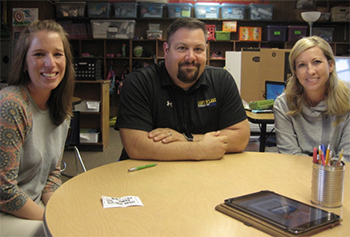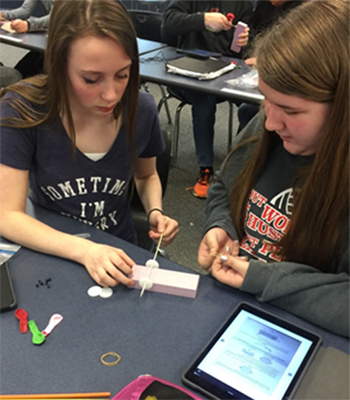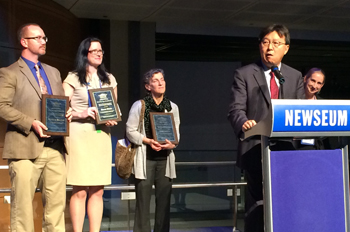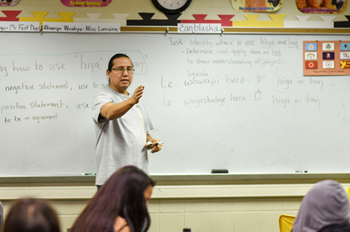Innovation:
Preparing students for a rapidly changing world

The traditional classroom is undergoing significant change, with educators asking one big question: How do we prepare students to succeed in a world that seems to be constantly changing? The answer for increasing numbers of districts is an innovative approach called customized learning. But what does that mean?
As the word “customized” suggests, the answer looks different in each community. Below is a sampling of how several South Dakota districts are implementing Classroom Innovation Grants – many of which aim to address principles of customized learning – that were also part of the 2016 education package.
Third grade teachers have begun with a collaborative approach to math that allows students to move more freely among groups, based on their strengths or need for additional instruction. “It’s been a lot easier to pinpoint specific needs of each individual student,” says 3rd grade teacher Carrie Baker.
“And I think we’ve gotten better at doing formative assessment to help inform that process,” says Cari Clark, dean of students and instructional support teacher. “We were doing it before, but perhaps weren’t as precise about really looking at that target and those success criteria.”
 Beyond the changes in core areas like math and reading, Canyon Lake will focus more on the whole student by developing what they are calling student-interest groups, or SIGs. SIGs may include yoga, pottery, coding, healthy cooking or maybe even fly fishing.
Beyond the changes in core areas like math and reading, Canyon Lake will focus more on the whole student by developing what they are calling student-interest groups, or SIGs. SIGs may include yoga, pottery, coding, healthy cooking or maybe even fly fishing.
Teachers at the school have taken a survey indicating what kinds of SIGs they would like to develop. Students also took surveys to indicate their areas of interest. During summer 2017, teachers will take this information and create SIGs to complement the school’s traditional specials: physical education, music and library. The first SIGs will be implemented in the fall of 2017.
“The options are really only limited by the imagination of our staff and the interests of our students,” Swank says. “We want our students to have access to some life experiences that economic barriers might prevent otherwise.”
 Chamberlain School District
Chamberlain School District
Chamberlain Middle School has become a 1:1 school by purchasing an iPad for every student. Grant funding has also been used to send staff to training on customized learning.
Principal Rick Pearson says the iPads provide more access for students to engage in the blended learning strategies that teachers are developing. Blended learning provides students opportunities to work more independently and move at their own pace. Teacher instruction is becoming more targeted to individual student needs, with students taking greater control over their own learning. “Education has remained stagnant as our students continue to adapt and change with the times,” Pearson says. “We are excited about allowing CMS students to have more choice in their education pathway!”
“I’m excited to be able to drive a cultural change in our middle school,” says Cadena Powers, a science teacher at Chamberlain Middle School.

As a Classroom Innovation Grant recipient, the Deuel School District is in the process of implementing mass customized learning. For the 2016-17 school year, teacher Matt Rosdahl began transforming all four years of his high school social studies classes.
“As I’ve been redesigning my curriculum, instead of world history for freshmen, geography for sophomores, American history for juniors, government and economics for seniors, everything is more integrated over the course of students’ four years,” Rosdahl says. “For instance, let’s say we’re studying the European Renaissance. Then at the same time, we’ll also study the geography of Europe.”
This year’s freshmen classes covered seven geography units, four world history units, a government unit and a unit on learning strategies and creating growth mindsets. “What I’m finding is that I can inject a few additional units we may not have gotten to otherwise,” Rosdahl says. “For instance, I had time to teach all of my classes a unit on elections and voting this year, with it being an election year.”
Staff in the Deuel School District are attending trainings, visiting customized classrooms in other districts and writing curriculum. “There is a component of mastery built in, so the student must attain knowledge day-to-day, rather than averaging a whole year of learning, just to say, ‘I learned these two things, failed several others, but on average passed the class,’” says Superintendent Dean Christensen.
Native American Achievement School Grants awarded

The following schools have been awarded grants:
• He Dog Elementary School, Todd County School District
• Todd County Middle School, Todd County School District
“These schools will be infusing Native American culture and language throughout their curriculum,” says Mato Standing High, director of the South Dakota Office of Indian Education. “Sometimes Native students struggle to feel a sense of belonging in our education system. It’s hard to learn when you don’t feel like you fit in. These grants are intended to help combat that problem. And the more students who feel like they belong, the better off every student in our state will be.”
The achievement schools are currently planning for implementation before official rollout of programs in fall 2019. Each awardee will receive $590,000 over the grant period.